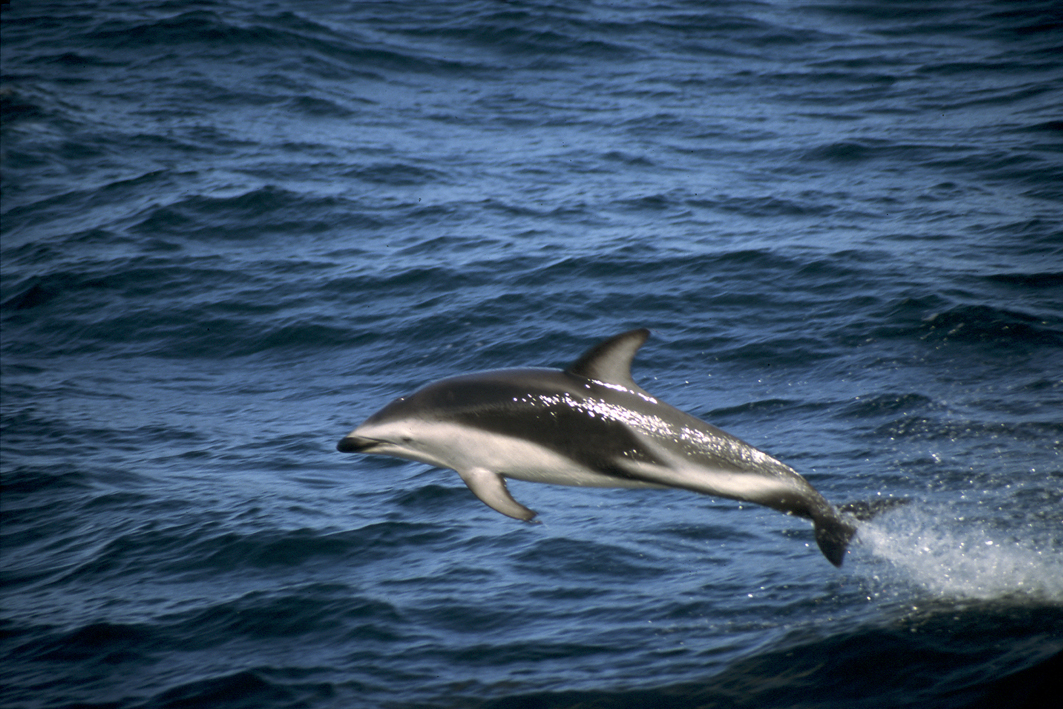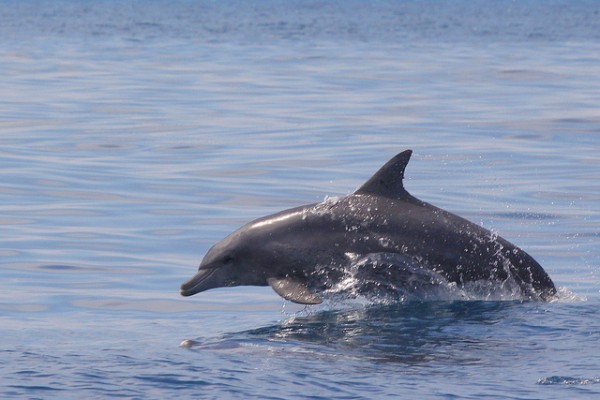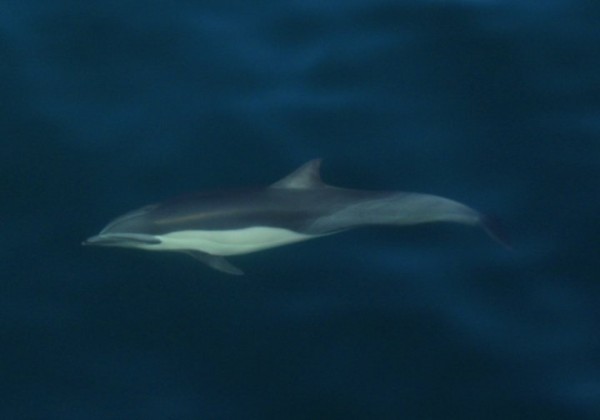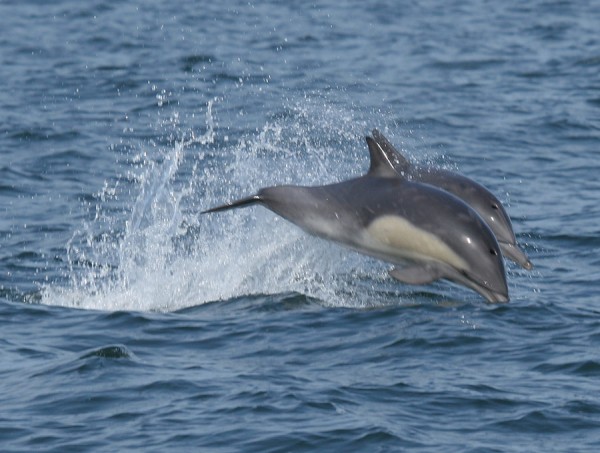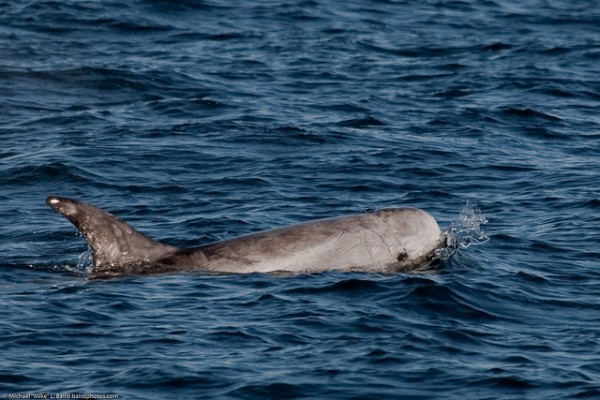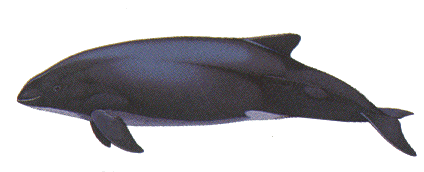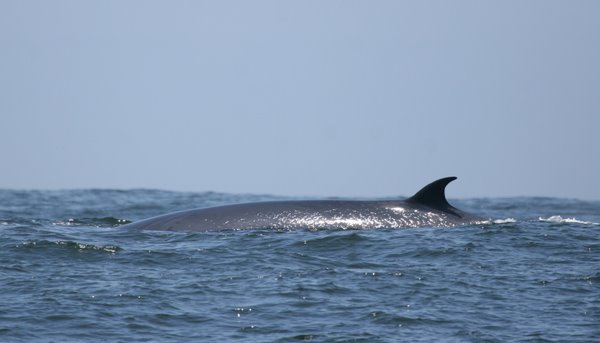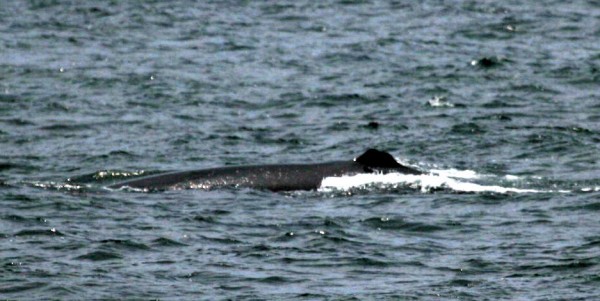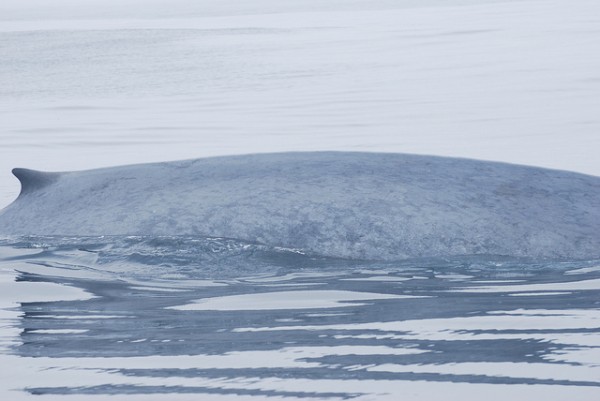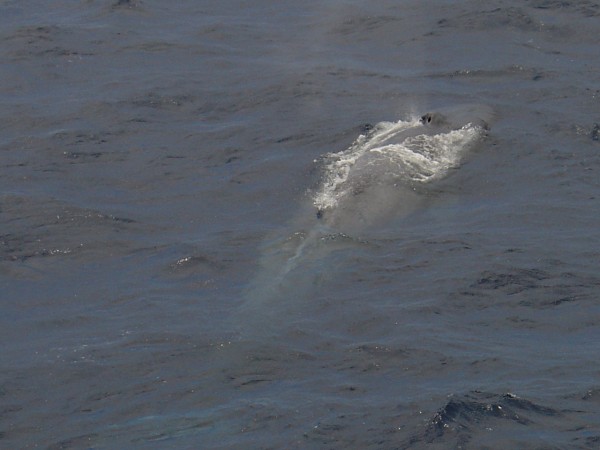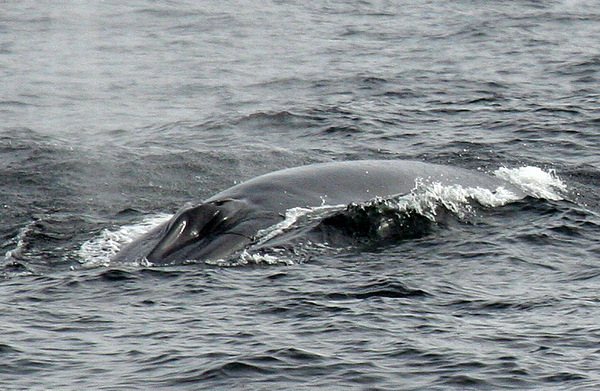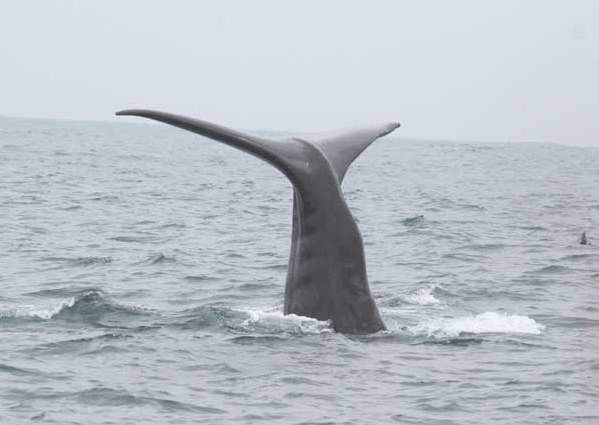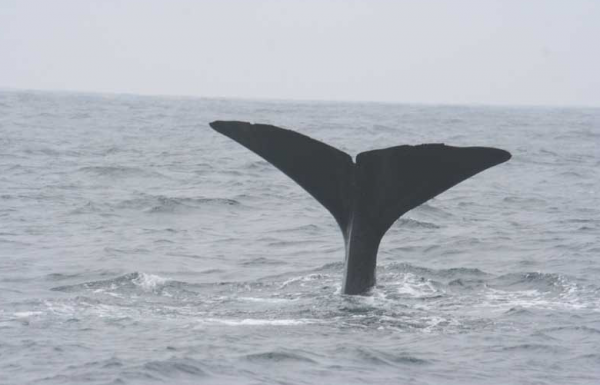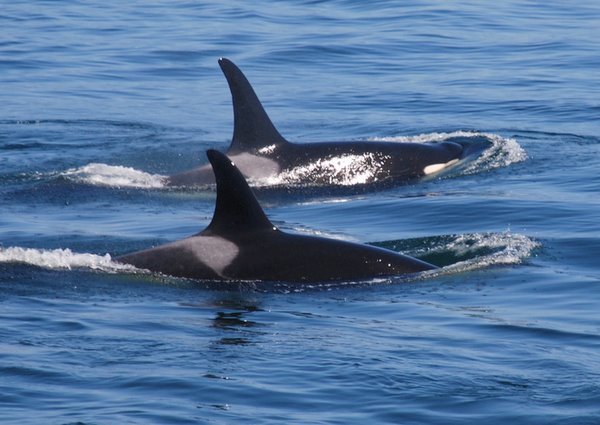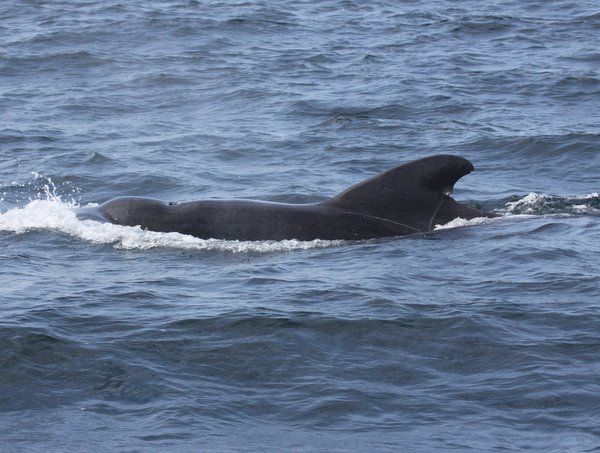Peru – Megadiverse for Cetaceans
If you’re fascinated with whales and dolphins, and live off a coastline that harbors over a third of all cetacean species in the world , you’d be crazy not trying to go out there and see them. If you don’t live here, let me introduce you to 15 species you can see off Peru. Maybe, you’d like to come to Peru and see some of them.
We are diversifying our business. Our love and your love for whales and dolphins can together build a new resource for whale/dolphin lovers and researchers alike. How? We shall get our own boat, and you could be our sponsor with a payback that vastly surmount your modest investment. I will give you a special offer which make you eligible to watch cetaceans at sea for FREE in Peru for the rest of your life plus many other bonus features. Interested? Scroll to the bottom. If not – scroll to the pictures.
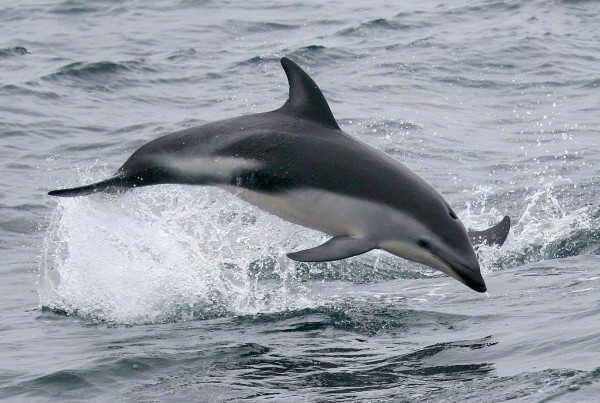
Some background to whale-watching in Peru
We have been running pelagic birdwatching trips since 2000 in Peru. Few people know that these trips originally were planned to be whale-watching trips. I didn’t think there was enough market of visiting birders to Lima to make pelagic birding trips with a profit. Whales and dolphins were different. Everyone likes them and would like to see them in the wild. Lima with 8-9 million people should have a click that may be interested and afford the trips.
I was right on one of the assumptions. There were a lot of people interested in whale-watching, BUT few people could afford the cost of 90 dollars.
The best strategy to at least see some cetaceans is to make a transect to the 1000m depth line at around 32 nmiles in the hope of seeing some Cetaceans on the way. You see, the cetaceans in Lima don’t have specific spots you can go to and expect to see one. Most are transient varying with the local occurrence of anchoveta banks and upwelling events bringing nutrients closer to the coast. We saw cetaceans on every trip, but different species every time. If there are patterns of occurrence these are not very obvious.
Birders on the other hand loved the transect and saw all their target birds and more. This allowed us to raise the price of the pelagics in order to also go out when there were few birders on board and sell space to occasional Peruvian non-birders who just want to see some cetaceans at a lower price. It became somewhat a mission to allow Peruvians enjoy the wonders of nature.
Over the years we have had a lot of interesting observations. In this blogpost I will go through some of the species we have seen during our trips.
Dolphins
We have seen five species of dolphins on our pelagics from Lima. Bottlenose Dolphin Tursiops truncatus and Dusky Dolphin Lagenorhynchus obscurus are the most numerous. Common Dolphin has recently been split to two species. The Short-beaked Common Dolphin Delphinus delphis and Long-beaked Common Dolphin Delphinus capensis. There are also a few records of Risso’s Dolphin Grampus griseus.
Dusky Dolphin Lagenorhynchus obscurus
The dusky Dolphin is well known for being very acrobatic in the wild making high 3 meter leaps out of the water. They can gather in huge flocks of over 100 individuals around the schools of anchoveta. We see duskies on most of our trips.
Identification: This is a small dolphin (around 1.6m) with an extremely short beak. Easily recognized by its black and light gray pattern and the triangular falcate dorsal fin with a pale thumb-mark.
Bottlenose dolphin Tursiops truncatus
Flipper as we all know it. Seeing wild Bottle-nosed Dolphins away from the aquariums is a treat. They often approach the boat to bow-ride. We see Bottle-nosed Dolphins on most of our trips.
Identification: They reach around 3m and thus larger than the other frequently encountered dolphins species. The prominent falcate dorsal fin and even grayish coloration are other good field marks.
Short-beaked Common Dolphin Delphinus delphis
The Short-beaked Common Dolphin is usually found in warmer waters. The photo is taken in Tumbes. It may be seen in Lima during Niño years or during the summer (January-February).
Identification: Short beak of course, but the other good mark is the mustard yellow side-patch and crisp contrast.
Long-beaked Common Dolphin Delphinus capensis
Long-beaked Common Dolphin is the Common Dolphin most frequently seen on Lima Pelagics. It is bound to cold water of the Humboldt Current.
Identification: Longer bill. The distinct side pattern is shared with Short-beaked Common Dolphin, although the Long-beaked Common Dolphin has more diffused pattern and the side patch more greenish-yellow in color.
Risso’s Dolphin Grampus griseus
Not very common in our waters, only a few records in Lima at deep water in June-July. Risso’s Dolphin can be found near the shelf edge where they feed on squid.
Identification: Identified on the heavily scared body. It has indistinct beak and a rounded head. The prominent (up to 50cm) dorsal fin makes it possible to mistake it for Bottle-nosed Dolphin and even Killer Whale at a distance, but the scared body usually gives it away. The scars are supposed to be caused by the teeth of other Risso’s Dolphins or the squid they pray on.
Burmeister’s Purpoise Phocoena spinipinnis
Not a true dolphin, but a Porpoise. Burmeister’s Porpoise is supposedly one of the most common cetaceans in South America, yet it is very difficult too see, because it does not surface very conspicuously. Usually only the dorsal fin is seen. We have one record from the Lima pelagics in July close to Callao. It is best looked for in very calm seas.
Identification: Small size and the triangular dorsal fin with small tubercles on the leading edge.
Baleen Whales
Lima has proved good to find baleen whales. The following species are found regularly. Bryde’s Whale Balenoptera edeni, Blue Whale Balaenopteridae musculus, Fin Whale Balaenoptera physalus and Sei Whale Balaenoptera borealis.
Bryde’s Whale Balenoptera edeni
Bryde’s Whale is resident off Lima and the Peruvian coast. This 11-15 m roqual can be seen year around, but since it often keep low, has a short blow, and does not show the tail when diving, it is easiest to see in calm conditions (normally November- April).
Identification:
Certainly, not straight forward to identify as its dorsal fin is very similar to Sei Whale. The top photo is by no means certain to species, but as it was taken in February when Sei Whale would more likely be found Sub-antartic waters. The only way to safely identify Bryde’s whale is observing the three parallel ridges on the head. See the picture below. 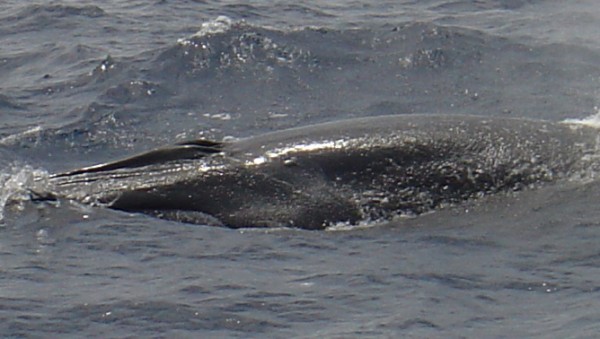
Bryde’s Whale can be difficult to see well as it often is very erratic under water. It is hard to predict where it will show up next time it surfaces.
Sei Whales Balaenoptera borealis
Sei Whale only occurs on passage in Peruvian waters. Taken into account that it is so hard to identify it is very little known about its presence in Peru. The above may or may not be a Sei Whale with a damaged dorsal fin – or it is again a Bryde’s Whale.
Identification: Sei Whale is 12-16 m and only has one central ridge on the head which separates it from Bryde’s Whale this way. Unlike other Rorqual they often feed just under the surface, which results in that the blow hole and the dorsal fin appear simultaneously.
Blue Whale Balaenopteridae musculus
Blue Whale is a magnificent animal. I have seen it a few times in Peru. Apparently there are two forms occurring. The normal 29 meter giant and a smaller pygmy form. This may or may not be the same Pygmy Blue Whale subspecies from the Indian Ocean. I have seen both forms of Blue Whale going out from Lima.
Identification: Both forms have sky blue skin and a very tiny dorsal fin. The bluish skin is typically covered with pale blotches. The normal Blue Whale often announce it presence with the huge blow that can reach 12m. It has a long cylinder like body. Maybe the best way to illustrate how big this form of Blue Whale is checking out the BBC video with David Attenborough as narrator.
The mysterious pygmy Blue Whale of Peru.
The Pymgy Blue Whale occurs normally in the Indian Ocean and the West Pacific and is named as a subspecies of Blue Whale and is sometimes is regarded as a full species. In Nov 2005 researchers from NOAA and Hadoram Shirihai recorded and photographed a pymgy form of Blue Whale about 300 nmiles off the Peruvian coast. In an online detailed report about Cockillaria Petrels and the pygmy blue whale the characteristics of this animal was registered. Check the photo of the head of this Pygmy Blue Whale.
They noted an animal which was shorter, had a shorter rostrum and instead of the long tubular shape this looked like a GIANT tadpole.
Preparing for this article Ignacio Garcia Godos gave me the photo above. This Blue Whale was recorded between Hawaii and Manta, Ecuador on a NOAA expedition that Ignacio attended in 2005. It was supposed to be a regular blue whale. It may be an artifact of the angle, but does this not correspond very well to the description above of the Pygmy Blue Whale?
In Nov 2007 on one of our pelagics we were around 30 nmiles out at sea and we were puzzled by 3-4 whales such as the one in the photo below. They had given away their presence from a distance with several blows, but these were short 3-4 meters high only and not at all the powerful plumes of the regular Blue Whale. At first I thought they were Bryde’s Whale because of small size similar to that of Bryde’s and that it kept low in the water and totally disappeared for a long while indicating deep submersions.
At closer range we could see that it lacked any pale mottling like the larger subspecies of Blue Whale as the photo by Mike Danzenbaker taken on this trip indicates.
Koen van Waerebeck thinks it may represent a non-described taxon that is resident in Peruvian Waters. Isn’t that exciting?
Take note that both this record and the record by Hadoram and NOAA team happened in November. We are organizing a deep sea-pelagic on Nov 6, 2011 – if anyone is interested joining us on a search for the “mysterious pygmy blue whale of Peru”
Pygmy Fin Whale Balaenoptera physalus ssp nov?
 Whalewatching in Peru is great because one may make important discoveries merely by taking photos and record position. In March 2007 we had 11 whales surrounding the boat. I did not know what they were and therefore took lots of photos.
Whalewatching in Peru is great because one may make important discoveries merely by taking photos and record position. In March 2007 we had 11 whales surrounding the boat. I did not know what they were and therefore took lots of photos.
Identification: Prominent dorsal fin. Eventually, I could see the right side of the lower jaw, which is white and the best field mark for Fin Whale. But there were features that did not fit. They were dark in color without the pale line on top that normal Fin Whale is supposed to have. And they were small. Most individuals were around 14-16 m and a few larger up to 18-20 meters. Normal Finwhales are around 24 meters.
Again I sent my pictures to Koen Van Waerebeck. He confirmed that this must be the Fin Whale which was hunted in the 20th century off Peru and thus most likely resident. Koen wrote up a manuscript (still in press) that was presented at the International Whaling Commission meeting in Anchorage in May 2007. I appeared as co-author by simply providing the pictures and the coordinates.
Other Whales
The other whales possible on Lima Pelagic whalewatching trips are Humpback Whale Megaptera novaeangliae, Sperm whale Physeter macrocephalus, Killer Whale Orcinus orca, Short-finned Pilot Whale Globicephala macrorhynchus and Peruvian Beaked Whale Mesoplodon peruvianus.
Humpback Whale Megaptera novaeangliae
 The photo above was from a November pelagic in 2003. Whalewatching outfitters love Humpbacks – because they always put on a great show. Although there is no breeding area in Lima or permanent winter population, they are often encountered on passage and sometimes they put on a show like this.
The photo above was from a November pelagic in 2003. Whalewatching outfitters love Humpbacks – because they always put on a great show. Although there is no breeding area in Lima or permanent winter population, they are often encountered on passage and sometimes they put on a show like this.
Identification: It is the easiest of all the big whales to identify. Long flippers with lots of white, showing huge fluke when diving with various amounts of white. No tail is like on other tail why tails should be photographed and deposited at one of the fluke picture repositories. A friend of mine Ignacio Garcia-Godos has started a fluke catalogue for Peru. We hope our continuous whalewatching pelagic trips will make new additions to the catalogue.
The dorsal fin is another good field mark as it has a hump in front of the fin. Hence its name.
Sperm Whale Physeter macrocephalus
Sperm Whales are found far away from shore at the continental shelf where they feed on giant squid. It is always an exciting whale to look out for near our turn around point.
Identification:
Very large toothed whale reaching up to 18m. The blow is directed forward. Very short dorsal fin, Show its totally black fluke when diving.
Killer Whale Orcinus orca
I have only seen Killer Whale once from Lima. It is a bit surprising that it is not more common regarding the enormous amounts of sea-lions present at Isla Palomino and at sea. I have been told it may be because of the straight coastline of Peru, there are few bays or sheltered areas where they can rest-
Identification: Male virtually unmistakable. The lack and w2hite pattern and the 6 ft (1.8m) tall dorsal fin gives it away immediately. The female with a smaller dorsal fin may be confused with Risso’s Dolphin or False Killer Whale (which is possible off Peru, but which we still have to find).
Short-finned Pilot Whale Globicephala macrorhynchus
We only have two records of this Pilot Whale. Once on the same trip we saw Sperm Whale at the deep sea and once in Tumbes.
Identification
Peruvian Beaked Whale Mesoplodon peruvianus
This little known small Beaked Whale was described in 1991 from a carcass on a beach in Peru by Reyes, Mead and Waerebeck. Additional specimens have been secured from sharkfishing by catch. Also, several sightings at sea between Mexico and Peru. In July 2006 an unidentified small beaked whale was seen by Dylan Walker and myself on a pelagic tour from Callao. We only saw a short triangular dorsal fin surrounded by a blackish back. We saw no white or other pale markings.
Identification: This is a very small beaked Whale. Only 5 meters long. That the male looks like the picture above is a hypothesis based on observations in the wild of individuals that look like this with a white field over the back. Presumably they are males Peruvian Beaked Whale, but it has not been proven. There are no specimens of the male. The female is uniform slaty in color and has a small but distinct melon on the head.
Special offer for whale and dolphin lovers.
Now you know what is awaiting you when you come to Peru and do whale-watching with us. As mentioned at the beginning of this post, you have the possibility to be able to go on our whale-watching and pelagic birding trips for the rest of your life for free. We are investing in our own boat. You will help us as You’ll become a member in:
Kolibri Expeditions VIP Club
Your investment is:
500 US$
Seems like a lot of money? By taking a few trips with us in Peru and elsewhere in South America, as Kolibri VIP you will regain you investment through a series of benefits. You don’t loose, we don’t have to borrow money and a permanent resource for nature lovers is created and puts Peru on the whale-watching map. Here are the benefits:
- One free space on a Lima pelagic/whalewatching once we have the boat that you can book on very short notice. You decide the date and we’ll run the pelagic – Value $175 to $1000 depending on the number of people taking part in the end.
- One free space on a Lima pelagic/whalewatching trip any day of the year, booked with minimum 9 months in advance. Value $175 to $1000 depending on the number of people taking part in the end.
- Perpetually free 1 day pelagic/whalewatching on standby basis – this also applies if we arrange pelagic away from Lima. Value $175 each time.
- Perpetually 10% discount on all our tours – discounting the airfares and train tickets. It will not only apply on Peru tours, but also on our international tours. On a two week tour this discount amounts to between $200-300
We mostly do birdwatching tours, but we are also arranging standard nature tours and cultural tours. Our activity is expanding also outside of Peru. - Perpetually free Lima day trips as long as there are 2 other paying clients. Value around $150 per trip.
Read more about the background of this offer on this previous blogpost. It also relates to our environmental, conservation and social commitment. The Special offer is valid until July 15. Extended to December 31, 2011.
Write me to sign up for the program or to ask questions how this can benefit you.
Our Whale-watching commitment
In the tropics in countries where regulations don’t exist, there are few operators of whalewatching who apply ethical standards to their operations. We are the difference to the rule.
- We don’t harrass the animals. Always keep a distance and let the cetaceans come to us if they like.
- We don’t do “swim with the sealions” or “swim with the dolphins” set-ups. Such practices are not allowed in for example the US. Why should we offer it here? We don’t care if the competitor does it and if there is no particular legislation against it. Furthermore, we find it utterly pointless to let our passengers bob around in lifejackets in the freezing Humboldt current.
- we avoid to break up fish schools where dolphins feed.
- we don’t seek out to get the dolphins bow-riding. If they come to us – fine – then we slow down to avoid accidents.
- If the sea allows it, we will shut the engines when near the cetaceans
- We collect observations and will share them with researchers from IMARPE (The Peruvian Sea Institute) and CEPEC (Centro Peruano de Estudios Cetológicos – Peruvian NGO directed by Koen Van Waerebeck, international specialist on Cetaceans often contracted by IWC). We will also publish the species lists and numbers of all outings.
Literature used for this article.
One can’t own too many books about Cetaceans. Here are some (affiliate) links to Amazon for the books that I have used to collect information for this article.
- Whales and Dolphins of the North American Pacific: Including Seals and Other Marine Mammals
Graeme Cresswell, Dylan Thomas and Todd Pusser
- Whales, Dolphins, and Other Marine Mammals of the World (Princeton Field Guides)
Hadoram Shirihai
- The Complete Guide to Antarctic Wildlife: Birds and Marine Mammals of the Antarctic Continent and the Southern Ocean (Second Edition)
Hadoram Shirihai
- Whales, Dolphins and Porpoises
Mark Carwardine
- National Audubon Society Guide to Marine Mammals of the World (National Audubon Society Field Guide)
Addionally, an excellent book by Julio Reyes to learn about Peruvian Cetaceans in Spanish can be found for free pdf download here.
Photos used in this article with permission or Creative Commons license: Humpback whale breaching – Image ID: sanc0605, NOAA’s Sanctuaries Collection, Dusky Dolphin (Lima, Peru) – Gunnar Engblom, Dusky Dolphin (Peru) – Ignacio Garcia-Godos, Bottle-nosed Dolphin (W Australia) – Marj Kibby, Short-beaked Common Dolphin (North Peru) – Ignacio Garcia-Godos, Long–beaked Common Dolphin (Lima, Peru) – Gunnar Engblom,Burmeister’s purpoise – whales.org, Probable Bryde’s Whale (Lima, Peru) – Gunnar Engblom, Bryde’s Whale (Lima, Peru) – Ignacio Garcia-Godos, possible Sei Whale – Gunnar Engblom, Blue Whale (California, US) – Dave Slater, BLue Whale (pygmy?) – Ignacio Garcia-Godos, Mystery Pygmy Blue Whale from Peru (Lima) – Mike Danzenbaker, Pygmy Fin Whale (possibly undescribed taxa, Lima, Peru) x 2- Gunnar Engblom, Humpbacck Whale x 2 (Lima, Peru) – Gunnar Engblom, Sperm Whale x2 (Lima, Peru) – Alejandro Tabini, Killer Whale (BC, Canada) – Miles Ritter, Peruvian Beaked whale illustration from Whales, Dolphin’s and Porpoises By Mark Carwardine.

